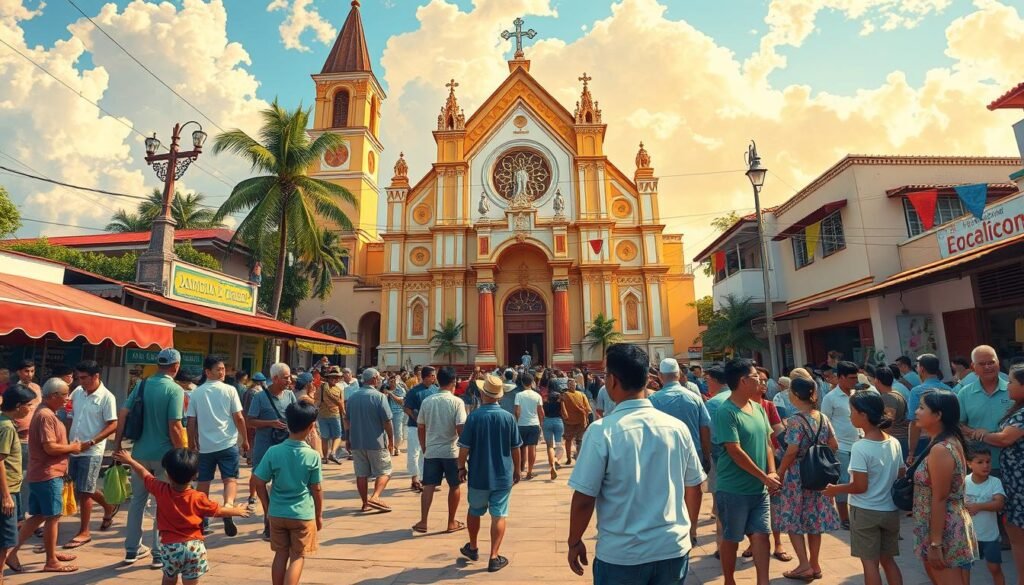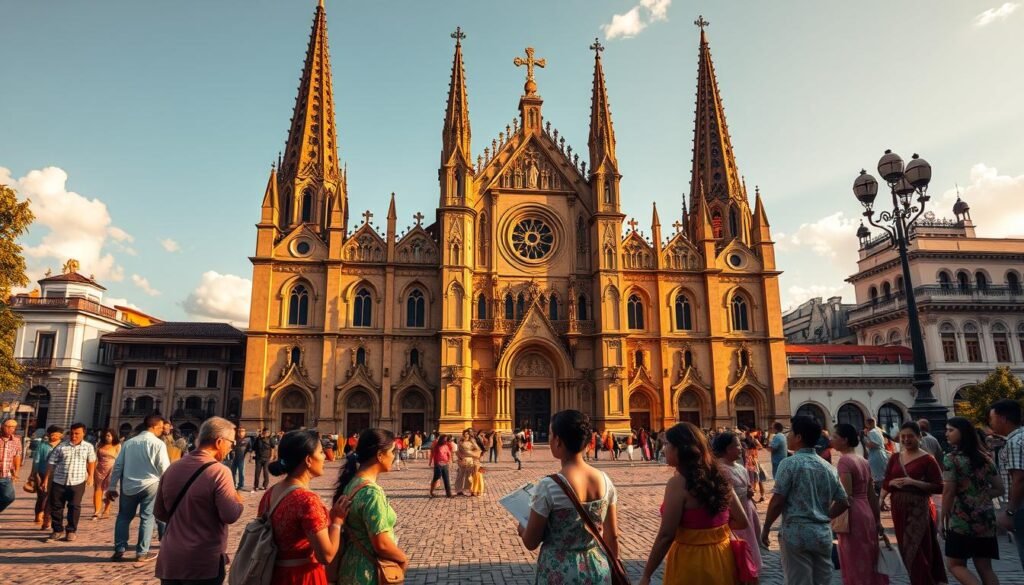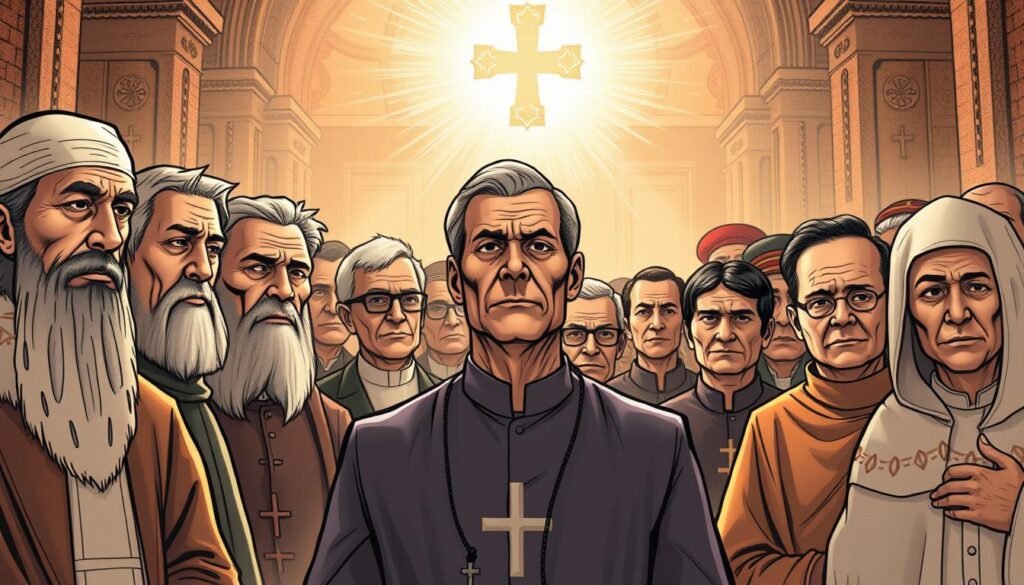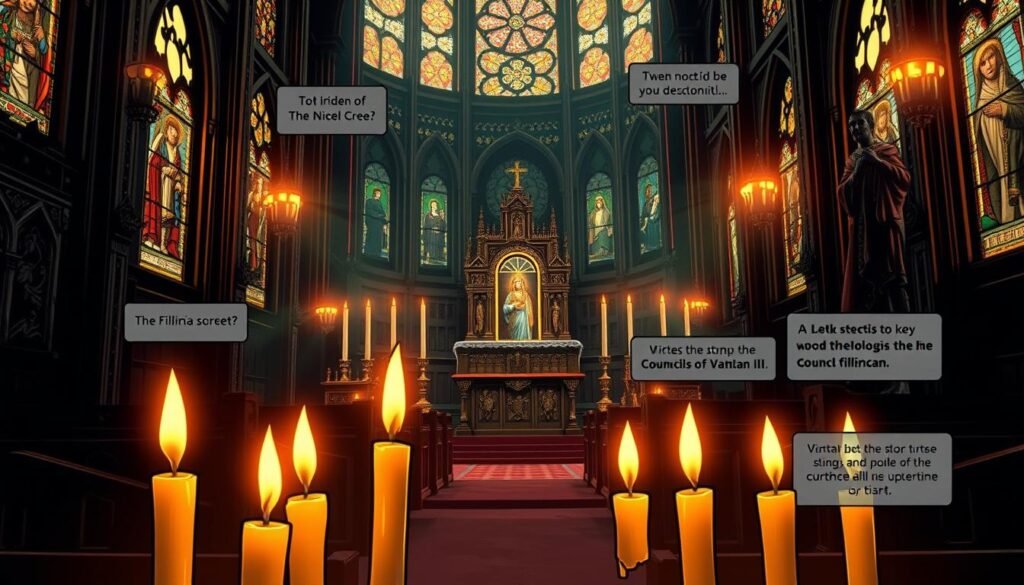The Catholic Church has long been a cornerstone of humanitarian efforts worldwide. With a membership of over 1.3 billion, it operates thousands of schools, hospitals, and charitable organizations. Its mission extends beyond spiritual guidance, offering tangible support to those in need.
In the Philippines, the Church plays a vital role in community development. It runs numerous programs aimed at education, healthcare, and disaster relief. These initiatives reflect its commitment to serving humanity, rooted in the teachings of God.
Globally, the Church’s influence is unmatched. It operates 5,500 hospitals and over 95,000 primary schools. These efforts demonstrate its dedication to improving lives, making it a key player in global humanitarian work.
Key Takeaways
- The Catholic Church is a major provider of humanitarian aid worldwide.
- It operates thousands of schools, hospitals, and charitable organizations.
- In the Philippines, the Church is deeply involved in community development.
- Its initiatives include education, healthcare, and disaster relief programs.
- The Church’s global reach and resources make it a key player in humanitarian efforts.
Historical Foundations of Church Aid and Support
The roots of collective charity can be traced back to early Christian practices. These communities were built on the principles of mutual aid and shared responsibility. House churches, often led by a single person, became hubs for both spiritual and material support.

Public gatherings played a crucial role in spreading the Gospel and organizing charitable efforts. Early believers pooled resources to help the needy, setting a precedent for future initiatives. This word of collective action became a cornerstone of Christian identity.
Early Christian Communities and Their Role
In the first centuries, Christian communities faced persecution but remained steadfast in their mission. They provided food, shelter, and care for widows, orphans, and the sick. These acts of kindness were not just charitable but also a testament to their faith.
Historical records highlight key moments, such as the Council of Nicaea in 325, which reinforced the Church’s commitment to social welfare. These early practices laid the groundwork for organized aid systems.
Medieval Expansion and Institutional Support
By the medieval period, the Church had evolved into a powerful institution. Monasteries and cathedrals became centers of community support. They built grain storage facilities, hospitals, and schools to serve the public.
This expansion was driven by the Church’s growing influence and resources. It marked a shift from small-scale charity to large-scale institutional aid, ensuring continuity from early practices to structured support systems.
The Evolution of the Church’s Humanitarian Mission
Papal endorsements have significantly shaped the Church’s role in global aid efforts. Over the centuries, its mission has evolved from spiritual guidance to active humanitarian work. This transformation reflects the integration of religious doctrine with practical charity, rooted in the teachings of christianity.

In the early centuries, the Church’s aid efforts were largely communal. Believers pooled resources to help the needy, setting a foundation for future initiatives. By the medieval period, this evolved into structured programs, with monasteries and cathedrals becoming centers of support.
Papal decrees played a crucial role in this shift. For example, Pope Gregory the Great in the 6th century emphasized the importance of caring for the poor. His teachings inspired the establishment of formal institutions, such as hospitals and orphanages, which continue to serve communities today.
Key Papal Figures and Their Contributions
Several popes have advanced the Church’s humanitarian mission. Pope Leo XIII’s encyclical Rerum Novarum in the 19th century addressed social justice, advocating for workers’ rights and fair wages. This document laid the groundwork for modern Catholic social teaching.
More recently, Pope Francis has highlighted the importance of recognizing human dignity. His initiatives, such as Caritas Internationalis, have mobilized global efforts to address crises like the Ebola outbreak and the Rohingya refugee crisis. These actions demonstrate the Church’s enduring commitment to humanitarian work.
Formal Institutions and Modern Impact
The Church has established numerous orders and organizations dedicated to social services. The Franciscans, for instance, focus on poverty alleviation, while the Jesuits prioritize education and healthcare. These institutions have shaped modern community support structures, ensuring continuity from early practices to today’s efforts.
In the Philippines, the Church’s long-standing presence has enabled it to respond effectively to disasters like Typhoon Haiyan. Its partnerships with local governments and NGOs have amplified its impact, showcasing the integration of faith and practical aid.
From its early communal roots to its current global reach, the Church’s humanitarian mission remains a testament to its enduring values. Its evolution reflects a commitment to serving humanity, guided by the principles of christianity and the leadership of key papal figures.
The Church and Community Engagement in the Philippines
Community-driven efforts in the Philippines highlight the Catholic Church’s active role in local development. Through various programs, it addresses critical needs in education, healthcare, and disaster relief. These initiatives are often supported by partnerships with government agencies and NGOs, ensuring a broader impact.

Local Church Initiatives
Across the Philippines, dioceses manage schools, hospitals, and social welfare programs. For example, the organization of Caritas Philippines has been instrumental in disaster response, providing immediate aid and long-term recovery support. Local parishes also run feeding programs and scholarship initiatives, reflecting the Church’s commitment to uplifting communities.
Historical traditions, such as the Bayanihan spirit, inspire these efforts. This cultural practice of communal unity aligns with the Church’s mission to serve the marginalized. Bishops, like Bishop Broderick Pabillo, have been vocal advocates for social justice, guiding these initiatives with a focus on human dignity.
Partnerships with Government and NGOs
Collaborations amplify the Church’s reach. For instance, during Typhoon Haiyan, the Church worked closely with the government and NGOs to rebuild communities. These partnerships ensure resources are pooled effectively, addressing large-scale challenges like poverty and disaster recovery.
One notable project is the St. Vincent de Paul Parish’s healthcare program, which provides free medical services to underserved areas. Such efforts demonstrate the power of public-private partnerships in creating sustainable change.
By combining faith-based values with practical solutions, the Church continues to play a vital role in shaping a better future for the Philippines.
Defining “Church”: Etymology and Cultural Significance
The term church has deep roots in both language and culture, shaping its identity across centuries. Originating from the Greek word ekklēsia, it referred to a gathering or assembly. This term was later adapted into Old English as cirice, evolving into the modern word we use today.

Initially, ekklēsia described a local gathering of believers. Over time, its meaning expanded to represent a global institution. This linguistic shift reflects the growing influence of the body of believers across the world.
In early Christian writings, the term was used to signify a unified community. St. Augustine’s theory in the 4th century described it as an invisible entity known only to God. This idea highlights the spiritual and theological depth of the word.
“The church is the new covenant people of God, a unified body of believers.”
Legally and historically, the term carries significant weight. The East-West Schism of 1054 and the Protestant Reformation in the 16th century shaped its modern interpretations. These events underscore its role as a source of authority and identity for communities of faith.
Today, the word continues to symbolize unity and mission. From local parishes to global organizations like the World Council of Churches, it remains a cornerstone of Christian identity. Its evolution mirrors the enduring cultural and spiritual impact of this ancient institution.
Architectural Heritage: From Sacred Buildings to Community Hubs
From towering cathedrals to modern community centers, sacred spaces have evolved significantly. These structures, once solely dedicated to worship, now serve as versatile hubs for education, culture, and social gatherings. This transformation reflects both historical influences and modern needs.

Transformation of Church Architecture Over Centuries
Early architectural styles, like Romanesque and Gothic, laid the foundation for sacred buildings. Romanesque designs, with their thick walls and rounded arches, emphasized strength and stability. Gothic architecture introduced pointed arches, ribbed vaults, and large stained-glass windows, creating a sense of divine light and elevation.
These styles were not just about aesthetics. They shaped how communities gathered and interacted. For example, Trieste Cathedral’s Gothic elements symbolize both spiritual and communal unity. Over time, these designs influenced public spaces, blending the holy with the practical.
Modern Adaptations for Community Use
Today, many sacred buildings are being repurposed to meet contemporary needs. Old chapels are transformed into libraries, museums, and even apartments. This shift preserves cultural heritage while addressing urban overbuilding and high maintenance costs.
Projects like the Columbia City Abbey Apartments showcase innovative design. They integrate original architectural features with modern functionality. This approach ensures these spaces remain relevant and accessible to all members of the community.
- Historical styles like Romanesque and Gothic shaped sacred architecture.
- Modern adaptations repurpose old buildings for new community uses.
- Innovative designs preserve heritage while meeting contemporary needs.
By blending history with innovation, sacred spaces continue to serve as vital community hubs. Their evolution reflects a commitment to preserving the past while embracing the future.
Influential Figures Shaping Church History
Throughout history, certain individuals have profoundly shaped the direction of religious institutions. Their contributions, rooted in scholarship and reform, have left a lasting impact on both theological thought and charitable practices. Among these figures, Hugh Paulin Cressy and Claude Fleury stand out for their significant roles in shaping the church’s mission and public perception.

Insights from Hugh Paulin Cressy
Hugh Paulin Cressy, a 17th-century English Benedictine monk, is celebrated for his scholarly works and commitment to ecclesiastical reform. Born in 1605, he initially pursued a career in the Anglican Church before converting to Catholicism. His writings, particularly Exomologesis, provided a robust defense of Catholic doctrine during a time of religious turmoil.
Cressy’s emphasis on the unity of the church and the importance of tradition influenced both his contemporaries and future generations. His work in Rome helped bridge theological divides, fostering a deeper understanding of Catholic teachings. Cressy’s legacy continues to inspire modern efforts to promote dialogue and unity within the faith community.
Contributions of Claude Fleury
Claude Fleury, a French historian and priest, made significant contributions to church history through his meticulous scholarship. Born in 1640, Fleury is best known for his monumental work, Histoire Ecclésiastique, which chronicled the development of the church from its earliest days. This text remains a cornerstone of ecclesiastical history.
Fleury’s focus on the practical aspects of church governance and charitable practices shaped his approach to reform. He believed that the church’s mission extended beyond spiritual guidance to include tangible support for the marginalized. His ideas influenced the development of modern social services, highlighting the enduring relevance of his work.
“The church’s mission is not just to preach but to serve humanity in all its needs.”
Both Cressy and Fleury played pivotal roles in shaping the church’s identity and mission. Their contributions to scholarship, reform, and charitable practices continue to resonate today, underscoring the importance of their work in the broader context of religious history.
Key Doctrinal Milestones and Their Impact on Aid
Doctrinal milestones have long guided the approach to social aid within religious institutions. These developments, rooted in theological principles, have shaped how support systems are designed and implemented. From early councils to modern encyclicals, each milestone has played a part in advancing charitable activities.

The First Ecumenical Council of Nicaea in 325 AD was a turning point. It established the Nicene Creed, affirming the belief in the Trinity. This doctrine emphasized unity and compassion, laying the foundation for organized charity. The Edict of Milan in 313 AD further supported this by ending Christian persecution, allowing the community to flourish.
In the medieval period, the Great Benedictine monastery of Cluny rejuvenated Western monasticism. It became a center for both spiritual and material support, influencing the design of future charitable buildings. These structures served as hubs for education, healthcare, and disaster relief, reflecting the integration of doctrine and practice.
“The church’s mission is not just to preach but to serve humanity in all its needs.”
Modern encyclicals, such as Rerum Novarum and Centesimus Annus, continue to shape aid policies. They advocate for social justice, workers’ rights, and a preferential option for the poor. These documents highlight the enduring relevance of doctrinal principles in addressing contemporary challenges.
From the Nicene Creed to modern encyclicals, doctrinal milestones have driven the evolution of aid systems. They remain a testament to the enduring commitment of religious institutions to serve humanity.
Ecclesiastical Governance and Its Role in Providing Services
Governance within religious institutions has evolved significantly over centuries. This structure ensures the effective delivery of social services, blending spiritual leadership with administrative efficiency. At its core, ecclesiastical governance balances centralized authority with community involvement, creating a system that adapts to changing needs.

Bishopric Leadership and Lay Involvement
Bishops have long played a central role in ecclesiastical governance. Their responsibilities include overseeing dioceses, managing resources, and guiding charitable programs. Historically, bishops were seen as both spiritual and administrative leaders, a dual role that continues today.
Lay members also contribute significantly to service delivery. Their involvement ensures that programs remain grounded in community needs. This partnership between clergy and laity has been a hallmark of effective governance throughout history.
Evolution of Governance Structures
From early councils to modern practices, governance has adapted to societal changes. The First Council of Nicaea in 325 AD established foundational principles, while medieval bishops expanded their influence to include social welfare. Today, governance models emphasize transparency and accountability.
| Period | Key Developments |
|---|---|
| Early Christianity | Communal leadership and shared responsibilities |
| Medieval Era | Bishops as both spiritual and secular leaders |
| Modern Times | Structured governance with lay involvement |
This evolution reflects the enduring commitment of religious institutions to serve humanity. By blending history with innovation, ecclesiastical governance continues to play a vital role in community support.
The Church’s Role in Education and Healthcare
Education and healthcare have long been pillars of the Church’s mission. Through schools, universities, and hospitals, it has provided essential services to communities worldwide. This commitment reflects its dedication to improving lives and fostering development.

Catholic Schools and Universities
Catholic educational institutions have a rich history. From humble beginnings, they have grown into a global network of schools and universities. These institutions are known for their academic excellence and integration of religious values.
In the Philippines, Catholic schools play a vital role in shaping young minds. They offer quality education, often in underserved areas. This practice ensures that even the most marginalized communities have access to learning opportunities.
Globally, Catholic universities are leaders in research and innovation. They combine faith with academic rigor, preparing students to make meaningful contributions to society. This dual focus has made them a cornerstone of modern education.
Healthcare Initiatives and Hospitals
The Church’s healthcare initiatives are equally impactful. Catholic hospitals provide compassionate care to millions annually. In the United States alone, they serve 16 million patients each year.
These institutions prioritize holistic care, addressing physical, emotional, and spiritual needs. The Code of Ethical Standards for Catholic Health and Aged Care Services guides their work, ensuring dignity and respect for all patients.
In the Philippines, Catholic healthcare facilities are often the first responders in times of crisis. During disasters, they provide immediate aid and long-term recovery support. This practice highlights their commitment to serving the most vulnerable.
| Institution | Impact |
|---|---|
| Catholic Schools | Provide education to underserved communities globally |
| Catholic Hospitals | Serve 16 million patients annually in the U.S. |
| Healthcare Programs | Focus on holistic care and disaster response |
The Church’s involvement in education and healthcare continues to evolve. By integrating religious values with academic and medical excellence, it remains a vital resource for communities worldwide. This enduring practice ensures a lasting social impact.
Cultural Contributions of the Church to Society
Artistic and cultural movements have long been intertwined with religious traditions, shaping societies across the globe. From the Renaissance to modern festivals, these institutions have inspired some of the world’s most celebrated achievements. Their influence extends beyond spiritual guidance, enriching art, music, and public traditions.
In many cities, religious architecture has become a defining feature. Gothic cathedrals, with their towering spires and intricate stained glass, are marvels of engineering and artistry. These structures not only serve as places of worship but also as cultural landmarks that attract millions of visitors annually.
Music has also been profoundly shaped by religious traditions. Gregorian chants, composed in medieval monasteries, laid the foundation for Western classical music. Composers like Johann Sebastian Bach drew inspiration from their faith, creating timeless works that continue to resonate today.
Public festivals and traditions often have religious origins. Events like Christmas and Easter are celebrated worldwide, blending spiritual significance with cultural practices. In the Philippines, the Sinulog Festival honors the Santo Niño, showcasing vibrant dances and music rooted in Catholic traditions.
“The arts are a bridge between the divine and the human, reflecting the beauty of creation.”
Collaborations between religious communities have further enriched cultural landscapes. For example, Protestant and Catholic artists in the Renaissance era worked together to produce masterpieces that transcended denominational boundaries. This spirit of cooperation continues today, fostering unity and creativity.
Religious institutions have also played a pivotal role in preserving cultural heritage. The Pontifical Commission for the Cultural Patrimony of the Church, established in 1993, promotes the conservation of artistic and historic treasures. These efforts ensure that future generations can appreciate the richness of their heritage.
| Cultural Contribution | Impact |
|---|---|
| Architecture | Gothic cathedrals as cultural landmarks |
| Music | Gregorian chants and classical compositions |
| Festivals | Public celebrations with religious origins |
| Art | Renaissance masterpieces inspired by faith |
From art and music to festivals and architecture, the cultural contributions of religious institutions have shaped societal identity. Their enduring legacy continues to inspire creativity and unity, bridging the gap between the past and the present.
Iconography and Symbolism in Church Buildings
Sacred symbols in religious buildings have long served as powerful expressions of faith and community identity. From the cross to stained glass, these elements are not just decorative but deeply meaningful. They connect worshippers to their beliefs and create a shared sense of belonging.
Sacred Symbols and Community Identity
The cross, a central symbol in Christianity, is often the focal point of religious architecture. It represents the sacrifice of the lord and serves as a reminder of faith. In many places, the cross is prominently displayed, reinforcing its importance in worship.
Stained glass windows are another key element. They depict biblical scenes and Christian symbols, educating the congregation about their faith. These windows also bring light into the place, symbolizing divine presence and hope.
Other symbols, like the fish (Ichthys) and the dove, carry specific meanings. The fish represents Jesus, while the dove symbolizes the Holy Spirit. These motifs are carefully chosen to reflect the values and beliefs of the community.
Comparing Catholic and Anglican Traditions
While both Catholic and anglican traditions use symbols like the cross, there are differences in their iconography. Catholic churches often feature elaborate statues and icons, while anglican churches tend to have simpler designs. These variations reflect theological and cultural differences.
For example, Trieste Cathedral showcases intricate Gothic architecture with detailed carvings and stained glass. In contrast, many anglican churches emphasize minimalism, focusing on the word of the lord rather than visual elements.
Evolution of Symbols in Religious Architecture
From early Christianity to modern adaptations, symbols have evolved to meet the needs of worshippers. Early churches used simple designs, while medieval cathedrals introduced complex iconography. Today, modern religious buildings blend traditional symbols with contemporary styles.
Design elements are deliberately chosen to reflect faith and communal values. High ceilings and vaulted arches draw the eye upwards, symbolizing a connection to heaven. The orientation of churches traditionally faces east, representing the resurrection of the lord.
“The arts are a bridge between the divine and the human, reflecting the beauty of creation.”
Iconography plays a vital role in maintaining cultural continuity. It preserves the stories and teachings of the faith, ensuring they are passed down through generations. Whether in a grand cathedral or a small chapel, these symbols continue to inspire and unite communities.
Church Architecture: Romanesque, Gothic, and Beyond
From thick-walled Romanesque structures to soaring Gothic cathedrals, architecture has shaped worship experiences. These styles reflect not only artistic innovation but also the spiritual and communal needs of the christian community.
Architectural Styles Defined
Romanesque architecture, prominent from the 10th to 12th centuries, is known for its solidity and strength. Thick walls, rounded arches, and barrel vaults define this style. These features provided stability and symbolized the enduring faith of the christian community.
Gothic architecture, emerging in the 12th century, introduced verticality and light. Pointed arches, ribbed vaults, and large stained-glass windows created a sense of divine elevation. This style emphasized the connection between heaven and earth, enhancing the spiritual experience of worshipers.
Evolution from Romanesque to Gothic Forms
The transition from Romanesque to Gothic marked a significant shift in architectural design. Romanesque buildings, like the Abbey of St Pierre de Moissac, focused on strength and simplicity. Gothic structures, such as Notre-Dame de Paris, aimed for height and light, symbolizing spiritual aspiration.
Technological advancements played a key role in this evolution. The development of flying buttresses allowed for taller walls and larger windows. These innovations not only improved structural integrity but also enhanced the aesthetic and functional aspects of sacred spaces.
Famous examples include Durham Cathedral, which blends Romanesque solidity with early Gothic elements. The Basilica of St Julian in Brioude showcases painted vaulting typical of Romanesque design. Meanwhile, Monreale Cathedral’s cloisters highlight the intricate details of Gothic architecture.
“Architecture is the thoughtful making of space, reflecting both faith and function.”
Modern interpretations of these styles continue to influence church design. Architects today blend traditional elements with contemporary needs, creating spaces that serve both spiritual and communal purposes. This evolution ensures that sacred architecture remains relevant and inspiring.
- Romanesque architecture emphasizes strength and simplicity.
- Gothic design focuses on verticality and light.
- Technological advancements enabled the transition between styles.
- Famous examples include Durham Cathedral and Notre-Dame de Paris.
- Modern churches blend traditional and contemporary elements.
For a deeper dive into the history of these architectural styles, explore this comprehensive guide.
Global Perspectives on Church and Aid Initiatives
Across the globe, faith-based organizations have become pivotal in addressing humanitarian crises. Their efforts span education, healthcare, and disaster relief, demonstrating a commitment to serving humanity. This section explores successful international models and compares their methodologies and outcomes.
Successful International Models
In East-Central Africa, church-led programs like Total Member Involvement and Revival and Reformation have achieved significant participation rates. These initiatives focus on community engagement and spiritual renewal, reflecting the purpose of faith-based aid. Similarly, Catholic Relief Services operates in over 80 countries, providing essential resources to those in need.
In the Philippines, the church’s role in disaster response has been exemplary. During Typhoon Haiyan, local parishes collaborated with NGOs to rebuild communities. This approach highlights how aid programs adapt to the specific needs of each country.
Comparative Analysis of Aid Programs
Different regions employ unique strategies to address local challenges. For instance, in North America, the focus is on refugee assistance, while in South Asia, education and healthcare take precedence. These variations underscore the importance of cultural and country-specific factors in shaping aid approaches.
Data from the Global Church Member Study reveals that participation in church-led programs is higher in East-Central Africa compared to other regions. This success can be attributed to the strong sense of community and shared purpose among members.
- Compare and contrast international models of church-led humanitarian aid.
- Illustrate examples of projects from different countries demonstrating effective community service.
- Analyze the purpose and methodologies that underscore successful aid programs.
For a deeper understanding of how faith-based organizations contribute to global development, explore this comprehensive analysis.
Modern Challenges and Future Directions for Church Services
In today’s rapidly changing world, faith-based organizations face unprecedented challenges. Secularization trends and evolving societal values are reshaping the role of religious institutions. To remain relevant, these organizations must adapt and innovate.
Navigating Secularization
Secularization has significantly impacted church attendance and influence. Studies show that younger generations, particularly Gen Z, are less likely to engage with traditional religious practices. This shift is driven by skepticism towards institutional authority and a preference for personal autonomy.
Faith-based organizations are responding by redefining their mission. For example, some are integrating technology into their programs, creating online platforms for worship and community engagement. Others are focusing on gospel-centered initiatives that emphasize personal connection and spiritual growth.
Adapting to Changing Community Needs
Communities today have diverse needs that require innovative solutions. Many churches are expanding their services to include mental health support, disaster relief, and educational programs. These efforts reflect a commitment to holistic care and community development.
In the Philippines, faith-based organizations are partnering with local governments to address pressing issues like poverty and education. For instance, some churches run school programs in underserved areas, providing quality education to children who might otherwise be left behind.
Technology is also playing a key role in modernizing church services. From live-streamed sermons to mobile apps for prayer and meditation, these tools help organizations stay connected with their members. This feature ensures that churches remain accessible and relevant in a digital age.
“The church must embrace change while staying true to its core values. Only then can it continue to serve as a beacon of hope in a rapidly evolving world.”
Looking ahead, faith-based organizations must balance tradition with innovation. By addressing modern challenges and adapting to community needs, they can continue to make a meaningful impact. For more insights, explore the challenges facing the 21st-century church.
Innovative Community Programs Led by the Church
Innovative community programs are reshaping how faith-based organizations engage with local populations. These initiatives blend traditional values with modern techniques, addressing pressing needs while fostering long-term development. From education to disaster relief, these programs demonstrate a commitment to serving humanity in practical ways.
Case Studies of Local Projects
In the Philippines, the organization of Caritas Philippines has launched transformative projects. One notable activity is their disaster response program, which provides immediate aid and long-term recovery support. This initiative has rebuilt communities devastated by Typhoon Haiyan, showcasing the power of faith-based action.
Another example is the Bayanihan spirit, which inspires communal unity. Local parishes run feeding programs and scholarship initiatives, reflecting a reformation in traditional practices. These efforts are not just charitable but also empower communities to thrive independently.
In East-Central Africa, programs like Total Member Involvement focus on community engagement and spiritual renewal. These initiatives have achieved high participation rates, demonstrating the effectiveness of faith-based activity in fostering social cohesion.
Methodologies and Funding Models
Successful programs often rely on partnerships with local governments and NGOs. For instance, during Typhoon Haiyan, faith-based organizations collaborated with the Philippine government to rebuild communities. This approach ensures resources are pooled effectively, addressing large-scale challenges like poverty and disaster recovery.
Funding models vary, but many programs rely on donations and grants. The St. Vincent de Paul Parish healthcare program, for example, provides free medical services to underserved areas. This initiative is funded through community contributions and international aid, highlighting the importance of sustainable funding.
“The church’s mission is not just to preach but to serve humanity in all its needs.”
Measurable Impacts and Replicability
These programs have measurable impacts on local development. In the Philippines, educational initiatives have increased literacy rates in underserved areas. Similarly, healthcare programs have improved access to medical services, reducing mortality rates.
The replicability of these practices is another key factor. Programs like Total Member Involvement can be adapted to other regions, addressing specific community needs. This flexibility ensures that faith-based organizations can continue to make a meaningful impact globally.
For more examples of successful innovative church-led community projects, explore this comprehensive resource.
Conclusion
From its origin in early Christian practices to its modern-day humanitarian efforts, the Catholic Church has remained a steadfast force for good. Its old traditions of charity and community support have evolved into structured programs that address education, healthcare, and disaster relief worldwide.
Over centuries, the Church’s governance and architecture have adapted to meet changing needs, reflecting its commitment to serving humanity. Its role in the Philippines, for example, highlights how faith-based initiatives can transform communities through partnerships and innovation.
As the Church continues to navigate modern challenges, its enduring mission remains clear: to uplift the marginalized and foster unity. By appreciating its historical legacy and modern achievements, we can better understand its vital role in shaping a compassionate world. Learn more about the unity of the church and its impact on global communities.
FAQ
What role did early Christian communities play in providing aid?
Early Christian communities were foundational in offering support to the poor, sick, and marginalized, embodying the teachings of Jesus Christ through acts of charity and mutual care.
How did the Catholic Church expand its humanitarian efforts during the medieval period?
During the medieval era, the Church established monasteries, hospitals, and charitable institutions, becoming a central force in providing education, healthcare, and relief to communities across Europe.
What are some examples of papal endorsements for charitable work?
Popes like Gregory the Great and Innocent III issued decrees and encyclicals encouraging almsgiving, care for the poor, and the establishment of charitable organizations, shaping the Church’s mission of service.
How does the Church engage with local communities in the Philippines?
In the Philippines, the Church leads initiatives such as disaster relief, education programs, and healthcare services, often collaborating with government agencies and NGOs to address community needs.
What is the origin and cultural significance of the term "Church"?
The term “Church” derives from the Greek word “ekklesia,” meaning “assembly.” It holds deep cultural and spiritual significance, representing both a physical place of worship and a global community of believers.
How has church architecture evolved to serve modern communities?
From Romanesque to Gothic styles, church buildings have adapted to meet changing needs, now often serving as multipurpose spaces for worship, education, and community gatherings.
Who were Hugh Paulin Cressy and Claude Fleury, and what were their contributions?
Hugh Paulin Cressy and Claude Fleury were influential historians and theologians whose writings provided insights into early Christian practices and the development of Church traditions.
What are some key doctrinal milestones that shaped the Church’s aid efforts?
Doctrines like the Corporal Works of Mercy and the Second Vatican Council’s emphasis on social justice have profoundly influenced the Church’s commitment to humanitarian work.
How does ecclesiastical governance support service provision?
Through bishopric leadership and lay involvement, the Church organizes and implements programs that address education, healthcare, and social welfare, ensuring effective community engagement.
What role does the Church play in education and healthcare globally?
The Church operates thousands of schools, universities, and hospitals worldwide, providing accessible education and healthcare services, particularly in underserved regions.
How does the Church contribute to cultural development in society?
Through art, music, literature, and education, the Church has preserved and enriched cultural heritage, fostering creativity and intellectual growth across generations.
What is the significance of iconography in church buildings?
Iconography, such as stained glass windows and religious statues, serves as a visual representation of faith, inspiring worship and reinforcing community identity.
How do Romanesque and Gothic architectural styles differ?
Romanesque architecture features thick walls and rounded arches, while Gothic styles emphasize pointed arches, ribbed vaults, and large stained glass windows, reflecting advancements in engineering and spirituality.
What are some successful international models of Church-led aid?
Programs like Caritas Internationalis and Catholic Relief Services demonstrate effective global aid models, addressing poverty, disaster response, and sustainable development.
How is the Church adapting to modern challenges in service provision?
The Church is embracing technology, fostering interfaith collaboration, and tailoring programs to meet evolving community needs, ensuring relevance in a rapidly changing world.
Can you provide examples of innovative community programs led by the Church?
Initiatives like urban farming projects, youth mentorship programs, and mobile healthcare clinics showcase the Church’s innovative approach to addressing contemporary social issues.
Source Links
- Catholic Church
- The Church and Internet
- Our History – DanChurchAid
- Why is it important to be familiar with church history?
- CATHOLIC ENCYCLOPEDIA: Church History
- The distinctive role of the Catholic Church in development and humanitarian response: 7 ways the Church makes a difference (February 2021) – World
- What is the church? | GotQuestions.org
- What we believe | The Church of England
- The Episcopal Church
- Church | Definition, History, & Types | Britannica
- The Origin and Nature of the Church
- Iconic Architectural Styles at Sacred Places | National Trust for Historic Preservation
- Transforming Sacred Spaces: 17 Adaptive Reuse Projects Revitalizing Churches
- History of early Christianity | Beliefs, Characteristics, Organization, & Map | Britannica
- History of Christianity
- Church’s 100th temple: A doctrinal milestone
- Timeline of the Catholic Church
- Compendium of the Social Doctrine of the Church
- Code of Canon Law – Book V
- Ecclesiastical Duties: Definition & Roles
- The institutions of ecclesiastical governance (Chapter 4) – Christian Law
- Health Care and Faith Communities: How Are They Related?
- Health Care and the Church's Mission
- The Cultural Heritage of the Church and Religious Families
- Christianity – Church, Society, Beliefs | Britannica
- Role of Christianity in civilization
- Iconography and Symbolism in Christian Church Design | illustrarch
- Symbolism in modern church architecture – GLM
- Romanesque architecture
- Romanesque Architecture Durham World Heritage Site
- Smarthistory – Romanesque architecture, an introduction
- The Impact of the World Church’s Initiatives on the Adventist Church in the East-Central Africa Division – Adventist Research
- The Evangelical Church Interacting between the Global and the Local – Lausanne Movement
- Called to Global Solidarity International Challenges for U.S. Parishes
- What Challenges Does the Church Face Today? How to Address Them
- The Biggest Issue Facing the Church Today – Jonathan Morrow
- 50 Ways to Take Church to the Community – Lewis Center for Church Leadership
- Community Action | The Church of England
- The Role of Women in the Church – Conclusions
- The Conclusion
- Conclusion – Grace Bible Church of Fort Worth

